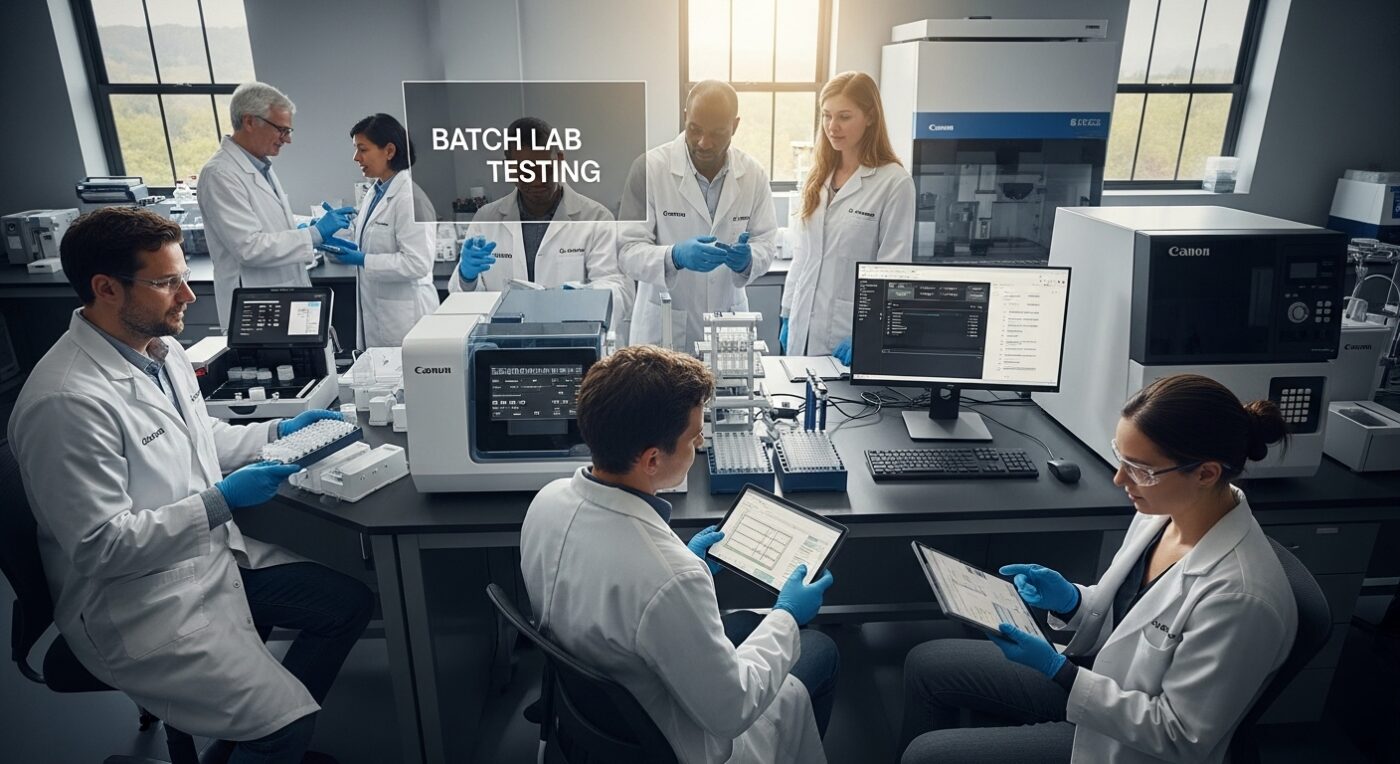Blog
What is Batch Lab Testing? Understanding Its Importance
Batch lab testing keeps products safe and consistent in industries from food to cannabis. Even with all the talk about quality, what surprises most is that every cannabis batch in California must be screened for pesticide residues, heavy metals, and microbial impurities by law. You might think this process is all about catching bad apples, but it actually sets the gold standard for reliability and consumer trust in a market where credibility can make or break a brand.
Table of Contents
- Defining Batch Lab Testing: What It Entails
- The Importance Of Batch Lab Testing In The Cannabis Industry
- How Batch Lab Testing Ensures Product Safety And Quality
- Key Concepts In Batch Lab Testing: Methods And Standards
Quick Summary
| Takeaway | Explanation |
|---|---|
| Batch testing verifies product safety | It systematically assesses a representative sample from production lots to ensure compliance with safety standards. |
| Essential for cannabis industry compliance | Batch lab testing is vital for regulatory adherence, ensuring products meet safety and quality benchmarks. |
| Advanced techniques detect contaminants | Modern methodologies like gas chromatography help identify minute chemical variations that might pose health risks. |
| Establishes product consistency | Systematic evaluations help ensure uniformity across production runs, boosting consumer confidence in the product. |
| Supports quality control protocols | Rigorous testing processes establish statistical quality benchmarks, safeguarding consumer interests and industry standards. |
Defining Batch Lab Testing: What It Entails
Batch lab testing represents a critical quality control methodology used across multiple industries to verify product consistency, safety, and performance. At its core, batch lab testing involves systematically examining a representative sample from a specific production lot or group to assess its overall characteristics and compliance with predetermined standards.
Understanding the Fundamental Concept
In scientific and manufacturing contexts, a batch refers to a defined quantity of material or product produced under uniform conditions during a single manufacturing cycle. When subjected to batch lab testing, this entire group undergoes comprehensive evaluation to ensure uniformity and meet rigorous quality specifications.
According to the FDA regulatory guidelines, batch testing involves characterizing a specific quantity of a test article to validate its inherent properties and performance attributes. This process serves several crucial purposes:
- Verifying product consistency across production runs
- Identifying potential manufacturing variations
- Ensuring compliance with established quality standards
- Detecting potential defects or anomalies
Technical Execution and Methodology
Batch lab testing follows a systematic approach where scientists select representative samples from a production lot and conduct thorough examinations. These examinations might include chemical composition analysis, physical property assessments, performance evaluations, and safety screenings.
The selected samples undergo meticulous testing using advanced laboratory techniques, measuring various parameters such as:
- Chemical composition
- Structural integrity
- Potency levels
- Potential contaminant presence
- Comparative performance metrics
By analyzing these samples, researchers can extrapolate findings to the entire batch, providing a comprehensive understanding of the product’s overall quality and reliability. This method allows manufacturers to maintain consistent standards and quickly identify and address potential issues before products reach consumers.
The Importance of Batch Lab Testing in the Cannabis Industry
Batch lab testing plays a pivotal role in ensuring consumer safety, regulatory compliance, and product quality within the cannabis industry. As cannabis transforms from a prohibited substance to a regulated market, stringent testing protocols have become essential for protecting public health and establishing industry credibility.
Consumer Safety and Regulatory Compliance
In the cannabis sector, batch lab testing serves as a critical safeguard against potential health risks. Learn more about our commitment to testing standards, which ensures that every product meets rigorous safety benchmarks. According to the California Department of Cannabis Control, comprehensive batch testing is mandatory and must screen for multiple potential contaminants
 :
:
- Cannabinoid potency verification
- Pesticide residue detection
- Heavy metal screening
- Microbial impurity assessment
- Mycotoxin identification
- Residual solvent analysis
Quality Control and Product Integrity
Beyond safety considerations, batch lab testing provides manufacturers and consumers with confidence in product quality. These systematic evaluations help identify variations in chemical composition, ensuring that cannabis products deliver consistent experiences and therapeutic potential.
The testing process involves sophisticated analytical techniques that measure precise cannabinoid profiles, terpene concentrations, and potential impurities. By examining representative samples from each production batch, laboratories can validate the product’s integrity and compliance with established industry standards.
The table below summarizes the key types of contaminants tested during cannabis batch lab testing, along with a simple description of each category.
| Contaminant Type | Description |
|---|---|
| Pesticide Residues | Chemical substances used to control pests that may remain on products after harvest. |
| Heavy Metals | Toxic elements like lead, arsenic, mercury, and cadmium tested to prevent consumer exposure. |
| Microbial Impurities | Microorganisms such as bacteria, molds, and yeasts that can cause illness or degrade product quality. |
| Mycotoxins | Toxic compounds produced by certain molds, potentially harmful if ingested. |
| Residual Solvents | Chemical solvents remaining from extraction or manufacturing processes that can pose health risks. |
| Allergens | Substances that may cause allergic reactions in sensitive individuals, requiring assessment for safety. |
Through meticulous batch testing, the cannabis industry demonstrates its commitment to transparency, scientific rigor, and consumer protection. This approach not only mitigates potential health risks but also builds trust in a rapidly evolving market segment, positioning lab testing as an indispensable component of responsible cannabis production.

How Batch Lab Testing Ensures Product Safety and Quality
Batch lab testing represents a sophisticated scientific approach to guaranteeing consumer safety through systematic product evaluation. By implementing comprehensive testing protocols, manufacturers can proactively identify potential risks and maintain rigorous quality standards across production cycles.
Comprehensive Contamination Detection
Chemical and biological contamination poses significant health risks in cannabis and other consumable products. Learn more about our third-party testing protocols that ensure unparalleled product integrity. According to the FDA’s guidance on quality control, systematic testing involves multiple critical screening processes:
- Identifying microbial pathogens
- Detecting heavy metal concentrations
- Screening for residual chemical compounds
- Assessing potential allergen presence
- Verifying molecular stability
Advanced Analytical Methodologies
Modern batch lab testing employs cutting-edge technologies like gas chromatography, mass spectrometry, and high-performance liquid chromatography. These advanced techniques enable precise quantification of chemical compositions, allowing researchers to detect even minute variations that could compromise product safety.
By analyzing representative samples from each production batch, laboratories can extract comprehensive data about product characteristics. This approach enables manufacturers to establish statistically significant quality benchmarks, ensuring consistent performance and minimizing potential consumer health risks through proactive contamination detection and detailed molecular analysis.
Key Concepts in Batch Lab Testing: Methods and Standards
Batch lab testing represents a sophisticated scientific methodology that demands precision, standardization, and comprehensive analytical techniques. By establishing robust protocols and rigorous evaluation methods, laboratories can ensure consistent, reliable, and reproducible results across diverse testing scenarios.
This table highlights foundational principles of batch lab testing, serving as essential steps for ensuring valid, reliable, and standardized laboratory analysis.
| Principle | Purpose |
|---|---|
| Clear Sampling Methodologies | Ensures samples accurately represent the production batch. |
| Precise Measurement Parameters | Defines exact criteria for assessing product characteristics. |
| Consistent Calibration Procedures | Maintains accuracy and repeatability of laboratory equipment. |
| Comprehensive Documentation | Provides a complete record for traceability and auditability. |
| Process Traceability | Guarantees every testing step can be tracked and verified. |
Foundational Testing Principles
Laboratory standardization is crucial for maintaining the integrity of batch testing processes. Read our comprehensive guide on lab verification, which highlights the critical elements of scientific testing protocols. According to the FDA’s research guidelines, batch testing must adhere to several fundamental principles:
- Establishing clear sampling methodologies
- Defining precise measurement parameters
- Implementing consistent calibration procedures
- Maintaining comprehensive documentation
- Ensuring traceability of testing processes
Advanced Analytical Techniques
Modern batch lab testing employs sophisticated analytical instruments and methodologies that enable unprecedented levels of precision and detail. Techniques such as gas chromatography, mass spectrometry, and high-performance liquid chromatography allow scientists to deconstruct complex materials into their molecular components, identifying and quantifying individual elements with remarkable accuracy.
These advanced methods provide researchers with comprehensive insights into product composition, enabling them to detect minute variations, potential contaminants, and subtle chemical interactions that might compromise product quality or safety. By combining multiple analytical approaches, laboratories can develop a holistic understanding of batch characteristics, establishing robust quality control frameworks that protect consumer interests and maintain industry standards.
Experience True Transparency and Quality with ACE Ultra Premium Co.
Are you worried about hidden contaminants or inconsistent quality in your cannabis vape products? After learning about the importance of rigorous batch lab testing, you know that safety and authenticity should never be compromised. At ACE Ultra Premium Co., we understand how critical these concerns are. Our entire product range features lab-verified testing, advanced extraction methods, and authentication tools, mirroring the rigorous standards discussed in our article about batch lab testing.

Discover how our detailed lab verification process and transparent product descriptions elevate your experience. Shop our full selection at https://aceultrapremiumco.com and enjoy the confidence of genuine safety, unrivaled quality, and clear peace of mind. Make your next purchase count by choosing products you can truly trust—visit us now and step into a new era of premium cannabis accessories.
Frequently Asked Questions
What is batch lab testing?
Batch lab testing is a quality control methodology that systematically examines a representative sample from a specific production lot to verify product consistency, safety, and performance.
Why is batch lab testing important in the cannabis industry?
Batch lab testing ensures consumer safety and regulatory compliance by screening cannabis products for contaminants, verifying cannabinoid potency, and maintaining overall product integrity.
What types of contaminants are tested during batch lab testing?
Batch lab testing screens for several potential contaminants, including pesticide residues, heavy metals, microbial impurities, mycotoxins, and residual solvents, to ensure product safety.
What advanced techniques are used in batch lab testing?
Modern batch lab testing employs advanced analytical techniques such as gas chromatography, mass spectrometry, and high-performance liquid chromatography to precisely analyze chemical compositions and detect minute variations.
Recommended
- Understanding Why Batch Testing is Essential for Cannabis – ACE ULTRA PREMIUM
- 7 Key Benefits of Third-Party Testing You Should Know – ACE ULTRA PREMIUM
- 7 Key Reasons for the Importance of Lab Verification – ACE ULTRA PREMIUM
- Understanding the Guide to Packaging Verification – ACE ULTRA PREMIUM

